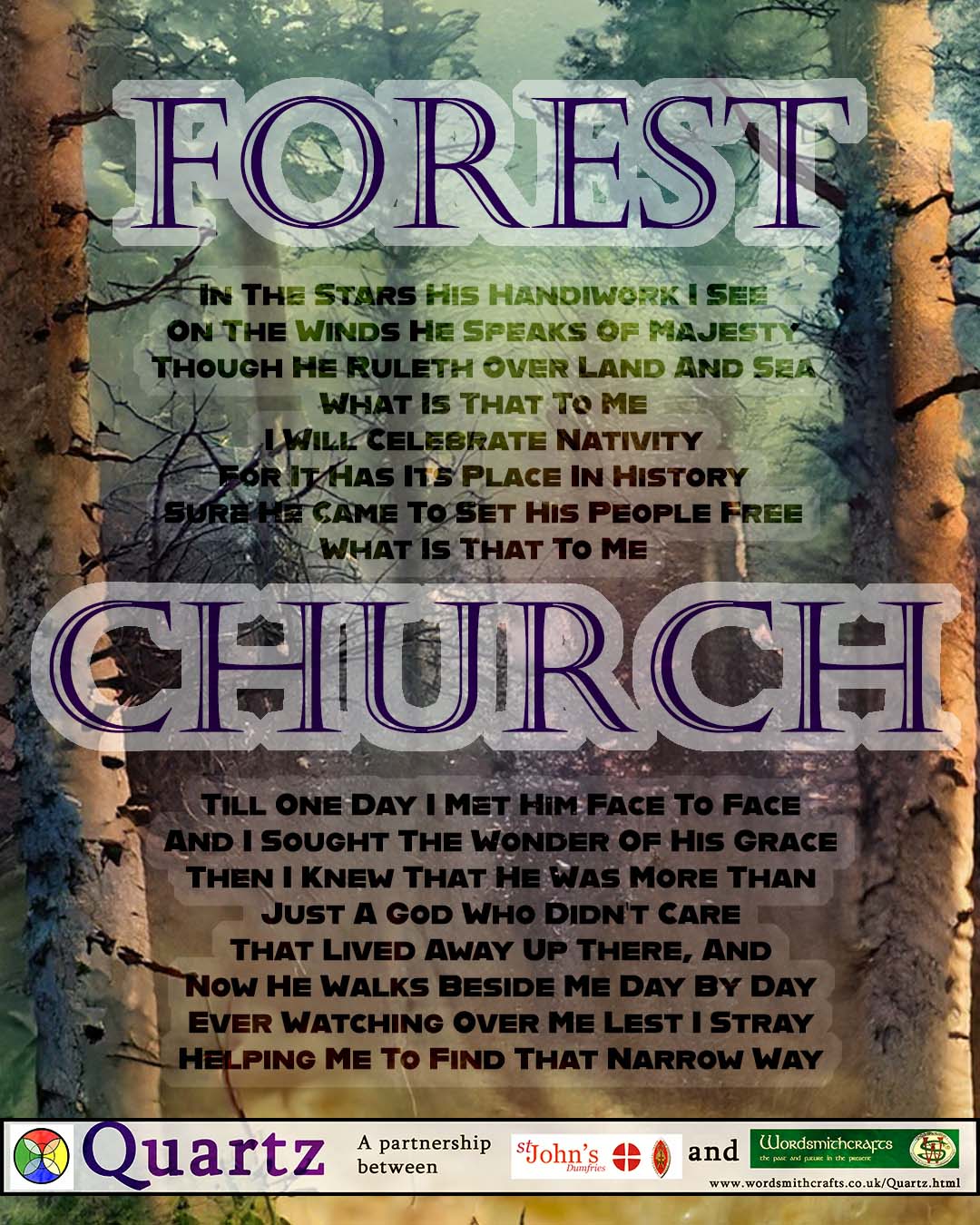What is Forest Church?
Click this link to skip to a general introduction to the concept …
What does Quartz Forest Church look like?
We have met once a month for over full year now. We have seen the leaves fall from the trees, grow and now rest on the ground again. We have started to become acquainted with the landscape of the Crichton estate and find favourite spots.
In addition to the regular monthly meetings we have also started to do something special about four times a year. For Easter 2023 we went on a pilgrimage, and met for a BBQ by the water.
Please join us on the 3rd Sunday of the month. Our usual meeting point is outside the Crichton chapel at 2pm. Dress for the weather! We adapt what we do to suit the people who gather and respond to the place we are meeting.
The nest section will give you a taste of what we have been up to when we gather. Click on the headings to explore each one in detail. Join the mailing list to find out about things before they happen!
- Forest Church SpecialFebruary Stargazing We will gather as usual at 2pm on Sunday the 18th of February outside the Crichton Chapel to practice #SensingSpirituality We will also have a spring special. Before the clocks change we will have an evening looking at the stars. Thanks to the hospitality of Ann Shuckman we will hold this at Elsieshields … Read more
- Psalter of the BirdsHere is a discussion about a new book by Author Justin Coutts on YouTube:. The conversation ranges from poetry which was composed in late antiquity to current mysticism online. So take a moment to slow down and recreate your mind. It is described as a collection of historical poetry and other texts from Ireland, Wales, … Read more
- January Forest Church21st of January 2024 2pm Meet outside the Crichton Chapel, Dumfries We meet outdoors and worship with the weather. Please dress accordingly! and bring a carry chair or anything else you need to make yourself comfortable. We will walk around the grounds of the estate, but save wilderness expeditions for special occasions. Physically, this gathering … Read more
- Spooling StoriesA gallery of reflections on Decembers Forest Church gathering. We gathered outside the Crichton chapel and watched the weather. I was a little wet and windy, but the rain mostly held off for our service. We remembered the solstice while we gathered, and perhaps the brooding pause between rain emphasised taking time to stand still. … Read more
- December Forest ChurchMarking a trail Following up on interest about Forest Church at the Christmas Tree Festival we will be meeting as usual 2pm on the 3rd Sunday outside the Crichton chapel. We will meet in Christs name, read (text and natural environment), pray and worship. We will also explore the readings and our life experiences by … Read more
A general introduction to Forest Church
The following introduction to “Forest Church – a field guide …” starts to answer this question.
(For a more complete discussion on the theme, please read the book!)
“A simple definition might be a group of people, outside, connecting with nature and worshipping God – but I don’t think that quite captures the magic, so a bit more detail is needed. Forest Church isn’t just normal church happening outside; instead it attempts to participate with creation.
We aim to learn, worship, meditate, pray and practice with the trees, at the spring, along the shore. Participants come with an attitude of experimentation, playfulness and readiness to connect with nature. God is present in creation and can be understood through creation; you’re in the sermon, the readings come from the Second Book of God.
The worship will happen when your heart is caught up in the beauty of the moment.
Forest Church is a fresh expression of church drawing on much older traditions when sacred places and practices were outside – but it is also drawing on contemporary research that highlights the benefits of spending time in wild places.
Already there are a few distinct versions of Forest Church emerging. Some people are taking a structured and liturgical approach to their events, others are simply providing a space with very little structure. Some people are facilitating groups who are strong on meditative or ritualistic practice, others have more of a field ecology focus on the flora and fauna around them. Some people are offering something distinctly Christian, some are at the fringes. Some groups meet for an hour and a half, some meet all day. Some groups are influenced by location and have to take into consideration the dangers of their local environment and the creatures living there. The setting might be rural or urban, Forest Church isn’t bound by location; it’s as possible in the city as in the middle of nowhere. And, no, you don’t need a forest.
Having said all that, I would argue that there are, or should be, some central ideas underpinning a generic understanding and description of Forest Church.
• Safety first – Forest Church should be safe to go to. Think about any hazards in the environment you’re going to and the safety of individuals. And consider the safety of the environment from your visiting it.
• It happens outside, in nature – In challenging weather, with a new group, it is hard not to move inside if there is that option but get the clothing, setting and activity right and weather doesn’t matter so much.
• Participate with nature – The aim isn’t to go into nature as if it is something separate from us, the idea is to let the barriers drop; to be with nature. This is explored more in Chapter 3.
• Events are site-specific – Gatherings should relate to, and be in dialogue with the specific setting they’re in. If what is happening could have happened inside, it might be wonderful but it isn’t really Forest Church.
• Allow time for nature to contribute – Nature speaks when it wants to. Build flexibility into events to allow this interaction to happen. This will develop as your group does – adults especially have to relearn the ability to listen but children do it naturally and in many ways are our teachers as far as nature connection goes.
• Recognises that God is revealed in nature – Since the creation of the world God’s invisible qualities – God’s eternal power and divine nature – have been clearly seen, being understood from what has been made (from Romans 1). T he idea is that we can explore the characteristics of the Creator by exploring the creation.
• God speaks through nature – Also recognise that God speaks through nature – we may need discernment and practice to hear and interpret meaning but nature is a source of Divine revelation (more in Chapter 2 on this).
• Aim to be regenerative in practise – Forest Church should try to mend some of the damage humankind has done to the natural world without making things worse. Picking up more litter than we drop is a simple example, as is offsetting any carbon spent by the event.
• In the Christ Tradition – Your wording might be different to mine but the intention of those operating under the Forest Church banner (via www.forestchurch.co.uk) is for Forest Church to have a Christ-centred vision at its core.
There are various expressions of Forest Church, from occasional events hosted by an existing church, to groups that operate independently. For these groups it may be relevant to explore the question ‘is it church’? That all depends on how you define ‘church’, but there isn’t anything that a traditional church can do, such as worship, fellowship, teaching, prayer, discipleship and the sacraments, (communion and baptism for example), that can’t be done by Forest Church – although how to do all of that isn’t covered in this book.
The potential for Forest Church is exciting. They’re free to set up; they’re fairly easy to start and potentially free to run. They are open to, and attract, a diverse group of participants, some of whom wouldn’t attend a traditional church.”

